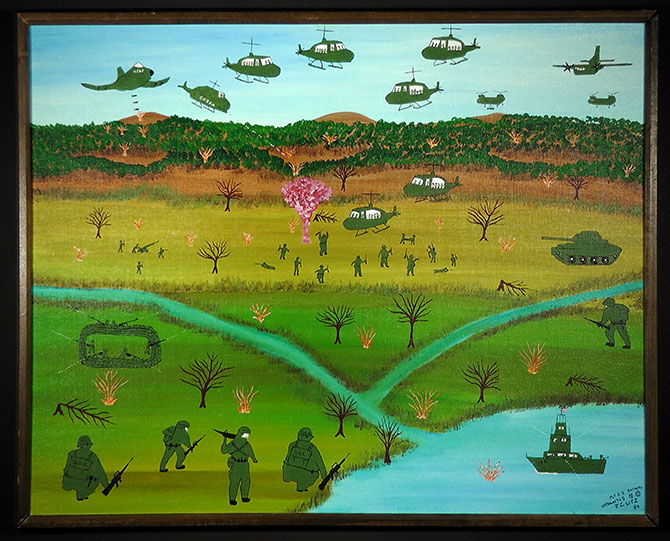One of Our Own
by Dean Brownrout

James Litz: Vietnam Infantry
There are some artists whose work is appreciated in obvious ways: We may be in awe of their precision; their work may directly reveal their education and training; or we may be amazed at the formal skills that are applied to the composition.
Then, there are artists whose work touches us in unquantifiable ways.
Western New Yorker James C. Litz (1948-2009) was such an artist. He received no art training. A veteran of the Vietnam War, Litz began painting at age 33 for “the feeling of peace” it gave him. Despite this lack of formal training, Litz’s most successful artworks are marvels of color, balance, proportion, and contrast.
It is easy to dismiss Litz’s work as primitive. The artist even described his work that way. But history has shown us that there are those self-taught “outsiders” who capture both the public’s imagination and the praise of the art intelligentsia with their very unquantifiable nature, whether it is unintended sophistication, subject matter, or another ephemeral element.
Only the most hard-hearted could not find something to like in the bounty of Litz’s art. In many of his works, the exaggerated perspective and childlike quality gently transport us to that peaceful place which the artist himself sought.
His work can also be powerful.
In Vietnam Infantry (1984), in the collection of the National Veterans Art Museum, one is pointedly reminded of the personal experience of the artist. This is not a depiction of a Marx Battleground toy play set. The scene of conflict and the artist’s style coalesce to form a jarring juxtaposition to the playful landscapes and domestic scenes that are predominantly featured in his art. The contrast speaks volumes.
While Western New York can lay claim to Litz being “one of our own,” as his regional popularity attests, Litz is by no means a local curiosity. His art is also represented in several important museum collections around the world, including the American Folk Art Museum in New York City and the Musée d’Art Naïf in Paris.
It is impossible to speak about Litz’s work without acknowledging its place in the long tradition of American folk art. Litz’s cannon continues a line of visual storytelling that reflects and documents the broad scope of the American experience.
Dean Brownrout is president of 20th Century Finest (www.20thcenturyfinest.com), dedicated to researching and trading in artwork by historically important, regional artists of the 20th century.
blog comments powered by Disqus|
Issue Navigation> Issue Index > v9n35 (Fall Arts, week of Thursday, September 2) > One of Our Own This Week's Issue • Artvoice Daily • Artvoice TV • Events Calendar • Classifieds |









 Current Issue
Current Issue